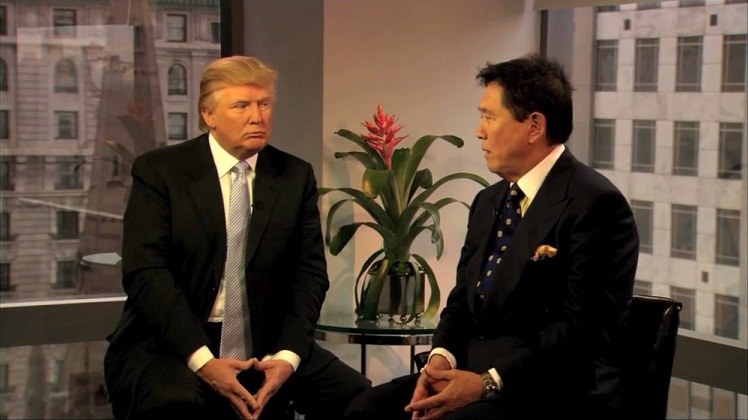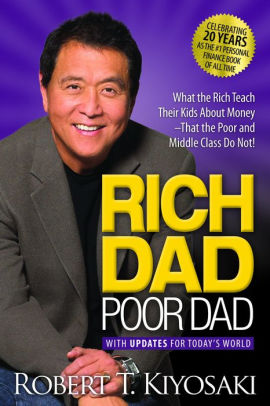Review: Rich Dad Poor Dad

Let’s cut right to the chase: I gained very little from this book. In between the pop-psychology, the right-wing apologism, the chapters that read as paid infomercials for the author’s other books and products, and the nauseating repetition, I gleaned precious few tidbits on how to grow your wealth. Adding to the problem is that many of these tidbits seem so broad and crashingly obvious that you begin to wonder if you’re being conned. Like a visit to the palm reader who foretells the most mundane of life’s coming attractions, Kiyosaki imparts basic wisdoms you could most likely arrive at on your own.
The prescription to build your asset column and pay less in taxes are hardly groundbreaking insights. Nor is the counsel that there’s no such thing as a no-risk investment. Neither is the instruction to pay experts for their expertise, and pay them well. It’s the steps in between that prove the bottleneck for most of us — the tricky part about acquiring the necessary funds to begin making meaningful moves financially. After the crippling student loans and exorbitant rent payments, those of us who call ourselves millennials have just barely enough to scrape together for living expenses like food and electricity, and far less for shrewd investments in stocks and real estate.
Kiyosaki urges that to become like the rich, we must seize the golden opportunities everyone else missed or passed over. “Great opportunities are not seen with your eyes. They are seen with your mind,” he writes (p. 200). If this sounds to you like utterly inactionable intel, you’re not alone. I personally need more than folk wisdom clichés before kickstarting my journey out of debt. Besides, golden opportunities don’t last long, and chances are that someone more financially secure than you are will have already pounced on it.
He does elaborate here and there on some of his honed practices, such as the scouting he does when surveying local real estate markets, and which assets he prioritizes in his portfolio (real estate and small-cap stocks, in case you were wondering). But most of these chapters are simply too thin on the ground to be of much use. For the most part, it’s the larger lessons that Kiyosaki’s interested in imparting, some of which may prove helpful to complete novices when it comes to investing.
His framing of cash flow is one of the more insightful areas of the book. He says that most people put their earned or ordinary income toward liabilities and expenses (the “Rat Race” reified by the middle class), whereas the smart investor procures income-generating assets that can cover expenses and, provided those cash flows are sufficiently large, can ultimately obviate the need for debt altogether. So for example, he advises to not buy a house until your mortgage can be paid entirely from asset-driven cash flows (e.g., passive or portfolio income) as opposed to active income. Prior to this, presumably, we would be better off remaining a renter*.
*(Yet in certain cases, namely high-value markets around the country, it can actually be cheaper to own than to rent. In places like New York, Denver, or Washington, DC, the monthly mortgage payment on a suburban house or condo can be cheaper than the rental cost of an apartment in the city. Especially if the market is expected to keep climbing, it can be more prudent to scrape the cash together for a down payment and start building equity than to continue throwing money into a rental black hole that you’ll never get back.)
You do learn a few other important items in the realm of finance, including the benefits of a 1031 tax-deferred exchange, the three basic types of income, and the relationship between an income statement and a balance sheet. But this kind of information is easily obtained elsewhere and is fairly common knowledge for anyone who attended business school. The balance of the book is, frankly, filled with folk psychology and teachings lifted straight from Sunday school. In his 10-step guide to cultivating your inner financial genius, one is titled “Teach and you shall receive: the power of giving”. Doing his best to channel self-help quack Rhonda Byrne in The Secret, he literally writes:
“If I could leave one single idea with you, it is that idea. Whenever you feel short or in need of something, give what you want first and it will come back in buckets…I know it is often the last thing a person may want to do, but it has always worked for me. I trust that the principle of reciprocity is true, and I give what I want. I want money, so I give money, and it comes back in multiples. I want sales, so I help someone else sell something, and sales come to me. I want contacts, and I help someone else get contacts. Like magic, contacts come to me.” (p. 305).
Perhaps the most controversial monetary advice he gives, or at least what cuts against the grain of conventional wisdom, is that a home is not an asset (but a liability), and that the old dogma of saving and diversifying is obsolete. I’m no financial guru, so I won’t come right out and declare this bad advice, but it seems to me that in terms of owning a house, it again depends on the market. If the value of your home is going up, you have an asset you can sell at a profit. If the local market is in decline, however, you can potentially be stuck with a property that is worth less than what you owe the bank, at which point it would indeed be strange to continue thinking of that property as an asset.
And one’s level of asset diversification depends on one’s aversion to risk, though for his part Kiyosaki recommends taking informed risks rather than playing it safe with a balanced portfolio. Any given investment, he writes, “is not risky for the financially literate…there is always risk. It is financial intelligence that improves the odds.” In fact it’s financial savvy, hard won through experience and failure, that turns what may seem to the uninitiated like gambling into informed investing.
That’s all sound as far as it goes, but I think what irked me most of all is Kiyosaki’s running theme that what separates the rich from the poor is, principally, financial literacy. Rich people know about loopholes in the tax code, for example, or hire expert accountants and financial advisers who do. The notion that it’s basic ignorance and psychological shortcomings that keep you from reaching the next level of financial security is one that’s repeated throughout. He writes:
“The main cause of poverty or financial struggle is fear and ignorance, not the economy or the government or the rich. It’s self-inflicted fear and ignorance that keep people trapped.” (p. 55)
And again on p. 85:
“Illiteracy, both in words and numbers, is the foundation of financial struggle. If people are having difficulties financially, there is something that they don’t understand, either in words or in numbers. The rich are rich because they are more literate in different areas than people who struggle financially. So if you want to be rich and maintain your wealth, it’s important to be financially literate, in words as well as numbers.“
Never mind his banally deplorable blaming-the-victim ethos. And we’ll also go ahead and ignore the systemic obstacles and inherent racial and class-based limitations that economically disadvantage tens of millions of people in America and elsewhere. Is it out of the question that Kiyosaki simply got lucky? Perhaps he made some good investing decisions early on that enabled him to acquire the kind of funds necessary to turn those initial profits into larger and larger profits. He even confesses to engaging in ultra high-risk plays initially:
“The stock plays I personally invested in were extremely high-risk for most people and absolutely not recommended. I have been playing that game since 1979 and have paid more than my share in dues. But if you will reread why investments such as these are high-risk for most people, you may be able to set your life up differently, so that the ability to take $25,000 and turn it into $1 million in a year is low-risk for you.” (p. 199)
That mileage will vary here should go without saying. And financial intelligence or no, a high-risk investment could bring a middling economic situation crashing down before your investing career gets off the ground. In such a situation, forking over twenty-five big ones to have another go isn’t in the cards, no matter how much self-help advice you imbibe over the course of the year.
Or, one could surmise, perhaps he rubbed elbows with the right folks who propelled him along the road to financial independence. One of his self-professed heroes is the “brash” Donald Trump, with whom he’s co-written a couple of books. (In a grand mix of irony and farcical flummery, Kiyosaki waxes poetic about how arrogance, which he ascribes to people who rarely read or listen to experts, is detrimental to wealth building, then name-drops Trump as a counter-example to which he aspires. That degree of delusion is priceless, regardless of the date of publication.)
He also takes frequent, irksome potshots at the value of education, though a charitable interpretation here is that Kiyosaki is lamenting how poorly universities prepare us for managing our finances. I heartily agree that personal finance should be a fundamental part of every young person’s education in order to help us navigate those more thorny adulting tasks such as obtaining a mortgage, managing a credit card, and investing in the stock market, CDs (certificates of deposit), government bonds, and other common financial instruments. Most millennials are sorely lacking in financial knowledge, and we could benefit greatly from acquiring this knowledge before it’s too late.
Finally, the author is just a generally poor writer, which to his credit, Kiyosaki freely and openly admits. This wouldn’t be nearly the problem that it is if the advice on offer was of broader utility and if it didn’t seem like the repetitiveness of it all was merely a ploy to cover up the thinness of the message. Alas, in the worst cases entire chapters seem to be retreads of earlier discussions. It’s even more galling because the exact words and phrasing are used each time a familiar point is raised, thereby avoiding even minimal contact with a thesaurus. And then of course there’s the hawking of his other books, seminars (which will run you as much as $5,000 a pop), and licensed board games, and the not-so-humble brags about his marketing prowess, which certainly doesn’t help with the conman vibe whatsoever.
Closing Thoughts
All in all, I won’t be recommending Rich Dad Poor Dad for those looking to escape the rat race of corporate America. Short on specifics, its focus is more on big picture concepts and gaining the right perspective on investing. It also feels cheap and gimmicky, not to mention mind-numbingly repetitive, and grounded in wish-fulfillment. Instead, I will recommend the following for their more comprehensive treatment of financial topics:
- The Complete Idiot’s Guide to Investing by Joshua Kennon (2006)
- The Essays of Warren Buffett: Lessons for Corporate America by Warren Buffett (1997)
- Warren Buffett Invests Like a Girl by The Motley Fool (2011)
- Warren Buffett’s 3 Favorite Books by Preston George Pysh (2012)
- Beating the Street by Peter Lynch (1994)
- The Money Masters by John Train (1980)
- The Intelligent Investor by Benjamin Graham (1949)
- Think and Grow Rich by Napoleon Hill (1937)
Note: This review is mirrored over at Goodreads and at Amazon.
Further reading:



Comments